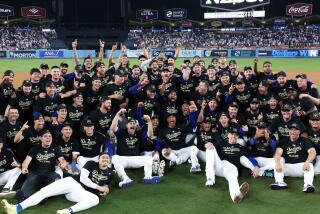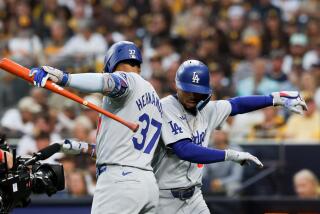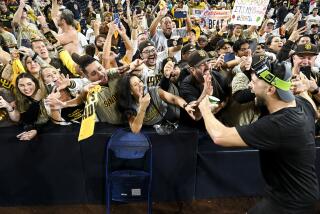Gwynn’s Batting Title Finishes Down-Up Year : Padres Can’t Afford to Stand Pat
SAN DIEGO — The duffel bags were packed and waiting. Phone numbers were hurriedly exchanged. Promises of keeping in touch over the winter echoed throughout the clubhouse.
The truth, each of them knows, is that few will get together during the winter. Some will never see each other again or, in some instances, will be wearing a new uniform if they do.
The scene in the Padre clubhouse Sunday was typical of the 22 other major league teams that won’t be in the playoffs this year. It will take time for them to realize that the baseball season is over, and they’ll relax and reminisce during the playoffs and World Series. But by the time the Christmas holidays roll around, they’ll anxiously await Feb. 16, when pitchers and catchers report to Yuma, Ariz. for the first workouts.
But this time when the Padres report to spring training, they say, it will be different.
This time, they say, they will have learned their lesson.
No matter how good their talent on paper, no matter what their accomplishments of spring training, they vow that they will not fall into the same trap as a year ago.
“That’s when all our problems started,” right fielder Tony Gwynn said, “in spring training. The way we won, it was like we felt we didn’t have to execute. We didn’t have to do the little things. We didn’t have to concentrate.
“I think what happened was that gave us a false sense of security, and by the time we realized what happened, it was too late.”
This was a team that went 18-8 in spring training, their best record in franchise history. There was Carmelo Martinez hitting six home runs with 17 RBIs, Marvell Wynne batting .354 and Dave Leiper going 3-0.
Well, it took until Aug. 26 for the Padres to reach and stay at .500 or better.
Martinez hit just six homers for the season and will not be re-signed.
Wynne was relegated to the bench by mid-season and traded in August.
Leiper was sent to the minors and never returned.
“Some of the guys we counted on didn’t come through,” Padre Manager Jack McKeon said. “We were very patient with them and in some cases, too patient. We waited as long as we could, and then had to make some changes.”
What was supposed to be the Year of the Padres instead turned into a season of transition.
They made three major trades during the season, deployed 40 players, including 17 pitchers, promoted Dick Freeman to president and hired Tony Siegle as vice president/player personnel.
Considering that free-agent pitcher Bruce Hurst was coming to the National League for the first time, first baseman Jack Clark was returning to the National League and McKeon was managing his first full season in the National League, the Padres indeed were in a state of flux.
By the time the roster was settled and everyone felt comfortable with one another, it was too late. The Padres won 29 of their final 39 games, but that left them second with a 89-73 record, three games behind San Francisco.
So, just who are the real Padres?
Is it the team that floundered at about .500 for 4 1/2 months? Or is it the team that posted a .744 winning percentage the final six weeks, allowing them to finish with the second-best record in the franchise’s 21-year history?
“It’s probably a combination of the two,” McKeon said. “I mean, that’s as good as we can play right there. We can’t play any better than that. I don’t think a club, not even the ’27 Yankees, can keep that pace for a whole season.”
Indeed, a .744 winning percentage would translate into a 120-42 record for a season, which would be the greatest record in baseball history.
“You have to strive for consistency,” McKeon said. “That’s the whole thing. The Giants were consistent; we weren’t. That’s why they’re still playing, and we’re going home.”
In many ways, this was an eight-month learning process for McKeon and the Padre organization.
The Padres learned that McKeon indeed has the instincts to be a strong manager as well as an astute judge of baseball talent. Never mind his 89-73 record, the best in his managerial career. This is a man who earned the respect of his players and in turn won their admiration.
There was Bip Roberts thanking McKeon Sunday for not being in the lineup and preserving his .300 batting average. Roberto Alomar was thanking McKeon for allowing him to play these past three days for a shot at .300. Bullpen stopper Mark Davis was thanking McKeon for putting him in Sunday’s game and allowing him to set the all-time Rolaids relief award record of 126 points (with 44 saves).
They might have been simple gestures with absolutely no bearing on the standings, but when you hear a guy like Jack Clark saying that he has enjoyed McKeon as much as any manager he has played for, you wonder if there’s some significance.
“I think we all found a lot about ourselves this year, I know I sure did,” said Clark, who hit 26 homers with 94 RBIs. “People keep asking if it was frustrating. But you know, it really wasn’t. We were the ones who buried ourselves early, I’m just surprised we jelled as well as we did by the end of the season.
“I think right now we have a good combination and the potential for continuing to play like we did at the end of the season. The most important thing we learned is that you don’t have to have great individuals to be a great team.
“If everybody does what they’re capable of, if everybody forgets about their own personal stats, we can all go a lot farther.”
Gwynn, who won his third consecutive batting championship (and fourth in six years) with a .336 average, said: “I think people saw a glimpse of how good this team can be. We learned the only way to win is to execute, and once we did that, for seven weeks we had a lot of people worried. If we can just put two halves together, I think we can win this thing.”
Still, as much as the Padres have improved themselves, they have a couple of glaring weaknesses to be corrected before they have a legitimate shot of winning the National League West.
First and foremost on the shopping list is a center fielder with power. Those who might be available include Eric Davis of Cincinnati, Joe Carter of Cleveland and Ellis Burks of Boston. The Padres also have their eyes on Darryl Strawberry of the Mets and Danny Tartabull of Kansas City, although they’re not center fielders.
Davis is the most attractive, and because he’s eligible for free agency at the end of the 1990 season and said he won’t return unless provided a three-year, $9-million contract, there will several teams trying to obtain him from the Reds in the off-season.
The Padres also would like a shortstop. Although Garry Templeton played admirably throughout the season, and most likely will be invited back, McKeon said that there were many days Templeton probably shouldn’t have been playing with his sore knees and that his playing time should be reduced.
The Padres once thought they had a shot to acquire Shawon Dunston from the Chicago Cubs, but he has since been taken off the market, and they now must face the fact that the outlook for finding a shortstop is bleak.
Their hope lies in Joey Cora, a second baseman throughout his career. Cora will travel to Phoenix today to join the instructional league and begin making the transition. He’ll also play shortstop this winter in Puerto Rico for Sandy Alomar’s team.
Next on the shopping list is pitching. Mark Langston of the Montreal Expos figures to enter the free-agent market, and if the Padres are able to acquire him, they’ll have one of the most formidable rotations in the league--Langston, Bruce Hurst, Ed Whitson, Andy Benes and Eric Show, Dennis Rasmussen or Calvin Schiraldi.
“We could use one more pitcher,” McKeon said, “because you just don’t know about Show after his back surgery. Will it the the same Show? Will it take him a couple of months to get going? Or will he even be there at all.”
If the Padres were able to acquire Langston, it would allow McKeon to strengthen his bullpen with Schiraldi. The Padres desperately need one more middle reliever to go along with Greg Harris and Mark Grant, setting up Mark Davis. McKeon said that if he were satisfied with his four men in the bullpen, he might enter the 1990 season with just a nine-man pitching staff.
McKeon, of course, also will tinker with the rest of his roster. He wants to strengthen his bench, and he still must find out if Mike Pagliarulo is capable of being an everyday third baseman. But he did find a pleasant surprise in Roberts and knows Roberts provides him the flexibility he needs to build a champion.
“I’m not going to come out and say we’re going to win a championship next year,” McKeon said. “The team that still scares me the most is Cincinnati, because you know that if they ever put it together, they’re going to win this thing.
“But I will say, just like I said this year, that we will be contend.
“Everyone’s goal at the beginning of the season was to win this thing, and we didn’t win it, so that was disappointing. But that was the only regret I had.
“These guys saw how close they could come if they really played together and played unselfishly. We made a run. We made a hell of a run.
“Hopefully next year will be the year teams will be running after us.”
PADRES MONTH-BY-MONTH
April (14-12 record)--The Padres finished the month in second, one game behind Cincinnati. With the exception of Tony Gwynn (.327), no regular hit higher than .235. The team hit just .232, scoring 84 runs in 26 games. Bullpen stopper Mark Davis was the bright spot on the pitching staff with 11 saves. Dennis Ramussen struggled (1-4, 7.20 ERA).
May (15-13)--The Padres finished the month third, 1 1/2 games behind San Francisco. Roberto Alomar and Gwynn each hit .309, but the club struggled to score runs (90 in 28 games). Ed Whitson had one of the finest months of his career, 5-0 with a 1.91 ERA.
June (10-16)--This is where the division title was lost. The Padres went 1-9 on their first trip of the month and finished June 8 1/2 games behind the Giants. They never completely recovered.
It started with three consecutive defeats in Cincinnati. Then, after winning in Houston on June 5, the Padres suffered the season’s most excruciating losses. They had a 7-4 ninth-inning lead on June 6 and lost, 8-7, in 10 innings. It will be remembered as the night catcher Benito Santiago did not step on home plate. Walt Terrell pitched one of his finest games of the season the following night, but the Padres lost, 3-2. And in the finale, the Padres had a 5-2 ninth-inning lead, but Davis blew his second consecutive save opportunity. The Astros tied it in the ninth and won it in the 10th on Glenn Davis’ home run.
The Padres lost three more games on the trip, to the Giants. Davis blew his third save of the month when he allowed a two-run triple June 24 to Giant first baseman Will Clark. He would blow just one of his final 26 save opportunities. The Padres also made their first major trade since spring training on June 2, sending Randy Ready and John Kruk to Philadelphia for Chris James.
The only player who would actually thrive was Gwynn, who hit .448, raising his average to a season-high .363 on June 29. Eric Show pitched for the last time on June 25; he underwent back surgery six weeks later.
July (12-13)--The Padres suffered a three-game sweep in Chicago before the All-Star break, then dropped four in a row at St. Louis afterward. The Cardinal sweep left the Padres a season-high 12 games behind the Giants with a 47-52 record. It would the first of many times the Padres would be written off for the season. Gwynn endured his worst month, hitting just .242 with four RBIs, while James won the club Triple Crown, leading the team in batting (.321), homers (five) and RBIs (15). The Padres picked up third baseman Mike Pagliarulo and pitcher Don Schulze from the New York Yankees on July 21 in exchange for pitchers Walt Terrell and Fred Toliver.
August (18-11)--This was the beginning of the Padres’ resurgence, including a 9-2 record after Aug. 19, and moved them within 6 1/2 of the Giants. This also was the month in which the Padres called up rookie pitcher Andy Benes. He lost his first two starts but picked up his first career victory Aug. 22 against Philadelphia and did not lose again until the Padres were mathematically eliminated. This also was the month in which Jack Clark got untracked, hitting eight homers with 23 RBIs. The Padres also made their third major trade, acquiring pitcher Calvin Schiraldi, outfielder Darrin Jackson and first baseman Phil Stephenson from the Cubs for outfielder Marvell Wynne and third baseman Luis Salazar.
September (19-7)--The roll continued but the Giants (17-11) kept going, too. The Padres had a chance to put fate back into their hands when the Giants were swept for the first time all season by the Dodgers, but the Padres lost Wednesday night, 2-1, in 13 innings to the Reds and were eliminated. It will be remembered as the night that the Padres pitched to Eric Davis with first base open, but the division title really was lost in June and July. Roberto Alomar paced the offense by hitting .365, while Benes went 4-1 with a 2.21 ERA, and Mark Davis saved 11 consecutive games with a 0.95 ERA.
More to Read
Are you a true-blue fan?
Get our Dodgers Dugout newsletter for insights, news and much more.
You may occasionally receive promotional content from the Los Angeles Times.









